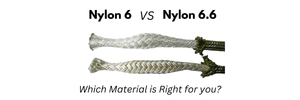If you've been off-roading long enough, you know one thing for sure—getting stuck is part of the adventure. Whether it’s buried in mud, caught in deep sand, or spinning your wheels in snow. Having a reliable kinetic rope can mean the difference between a quick pull-out or a long, frustrating day. But not all ropes are built the same, and that’s where the choice between Nylon 6 and Nylon 6.6 comes in. Most brands opt for Nylon 6 because it’s significantly cheaper to produce, while only a few high-end brands use Nylon 6.6. However, we break the mold by using Nylon 6.6 while keeping our ropes cost-effective, ensuring that off-roaders get top-tier performance without the premium price tag.
Real-World Performance: Nylon 6 vs. Nylon 6.6
Nylon 6 ropes are a good fit for those looking for maximum stretch. If you've ever needed a hard yank to free a vehicle from a sticky situation. This extra stretch makes it great for aggressive recoveries, especially when you need to get a rig unstuck fast. The downside? After a few recoveries, that stretch starts to wear out. If you’re constantly hitting tough trails and using your rope frequently, you’ll notice it losing elasticity over time and needing replacement sooner.
Nylon 6.6, on the other hand, is for the off-roader who wants a balanced mix of stretch and durability. It doesn’t have quite the same level of elongation as Nylon 6, but it still provides enough give for any recovery. More importantly, it holds up to frequent use without degrading as quickly. If you’re the kind of off-roader who spends weekends exploring trails and doesn’t want to replace your gear every few months, Nylon 6.6 might be the smarter investment.
Which One Suits Your Off-Road Style?
-
For extreme, high-energy recoveries: Nylon 6 is the better choice, offering maximum stretch to absorb shock and pull vehicles out fast.
-
For frequent, all-around recoveries: Nylon 6.6 provides a balance between flexibility and durability, meaning it lasts longer while still delivering effective recoveries.
-
If you don’t want to replace your rope often: Nylon 6.6 holds up better in the long run, while Nylon 6 will need more frequent replacements due to stretch degradation.
Heat, Moisture, and Wear: The Long-Term Durability of Nylon 6 vs. Nylon 6.6
Durability isn’t just about how long a rope lasts—it’s about how well it holds up under tough conditions. Heat, moisture, and abrasion are all factors that impact the lifespan of a kinetic rope, and Nylon 6 and Nylon 6.6 perform differently in each of these areas.
Heat Resistance: Nylon 6 has a lower melting point (about 428°F), meaning it softens and degrades more quickly under repeated friction from heavy recoveries. Nylon 6.6 has a higher melting point (about 500°F), making it better suited for enduring frequent high-friction use without breaking down as fast.
Moisture Absorption: Nylon 6 absorbs more water (up to 9% of its weight), which can weaken the fibers over time, especially in wet environments. Nylon 6.6 absorbs significantly less moisture (around 4-5%), allowing it to retain strength and structure even after multiple water-heavy recoveries.
Abrasion and Wear: Sand, dirt, and debris are inevitable when off-roading, and they can wear down a rope fast. Nylon 6 has softer fibers that trap more grit, causing it to fray and weaken faster. Nylon 6.6 has a tighter molecular structure, making it more resistant to abrasion, so it lasts longer when dragged across rough terrain or used in sandy conditions.
For off-roaders who frequently recover vehicles in challenging conditions, these factors play a huge role in deciding which rope is best. While Nylon 6’s extra stretch is beneficial for certain recoveries, it comes at the cost of long-term resilience. Nylon 6.6 provides a more durable solution for those who need a rope that can withstand repeated use without significant degradation.
Why Our Kinetic Ropes Stand Out
Our Kinetic-X ropes are built for real off-roaders—designed to handle extreme recoveries while maintaining long-term durability. By using premium Nylon 6.6, we ensure a balance of performance and affordability. Along with our tightly wrapped exterior layer, we further prevent the elements from penetrating the rope, keeping out moisture, dirt, and debris that can degrade performance. Additionally, our highly reflective strands enhance nighttime visibility, ensuring safer recoveries in low-light conditions. We make sure to cover you on all ends, so you can hit the trails with confidence.
Technical Comparison of Kinetic Rope Structure
| Property | Nylon 6 Rope | Nylon 6.6 Rope |
|---|---|---|
| Fiber Structure | Looser molecular bonds, softer fibers | Tighter molecular structure, more rigid fibers |
| Strength | High strength but weakens faster with repeated use | Higher tensile strength, holds up longer under stress |
| Stretch & Recovery | Higher stretch, best for aggressive recoveries | Moderate stretch, balances recovery and longevity |
| Water Absorption | Absorbs up to 9% of weight, weakens over time | Absorbs only 4-5%, maintains structure in wet conditions |
| Abrasion Resistance | Softer fibers, wears down faster from sand/dirt | Tougher fibers, resists abrasion and rough terrain |
| UV Resistance | More prone to UV degradation over time | More resistant to UV exposure, lasts longer in the sun |
| Flexibility Over Time | Becomes brittle faster with frequent use | Maintains flexibility for longer use |
| Friction Heat Tolerance | Lower melting point, can degrade with excessive friction | Higher melting point, withstands more heat stress |
By understanding the structural differences, you can choose the rope that best fits your recovery needs and off-road adventures.

